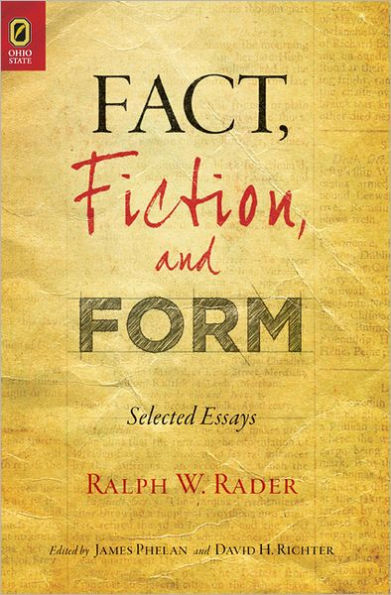Ralph W. Rader, along with Sheldon Sacks and Wayne Booth, was one of the three leading figures of the second generation of neo-Aristotelian critics. During his long career in the English Department at the University of California, Berkeley, Rader published scores of essays. Fact, Fiction, and Form: Selected Essays, edited by James Phelan and David H. Richter, collects the most important of these essays, all of them written between the late 1960s and the late 1990s. These critical inquiries, which engage with a remarkable range of literary texts—Moll Flanders, Pamela, Tristram Shandy, “Tintern Abbey,” “My Last Duchess,” Barchester Towers, Lord Jim, Ulysses, and more—are a rich resource for anyone interested in criticism’s ongoing conversations about the following major issues: the concept of form, the genres of the lyric and the novel, the literary dimensions of literary history, the distinction between fiction and nonfiction, the evaluation of literary quality, and the testing of theories and of interpretations. Moreover, the essays collectively develop a distinctive, coherent, and compelling vision of literary form, purpose, and value. Rader’s vision is distinctive and coherent because it is based not on an underlying theory of language, power, history, or culture but rather on the idea that form is the means by which humans respond to fundamental aspects and conditions of their existence in the world. His vision is compelling because it includes a rigorous set of standards for adequate interpretation against which he invites his audience to measure his own readings.
1102897685
Fact, Fiction, and Form: Selected Essays
Ralph W. Rader, along with Sheldon Sacks and Wayne Booth, was one of the three leading figures of the second generation of neo-Aristotelian critics. During his long career in the English Department at the University of California, Berkeley, Rader published scores of essays. Fact, Fiction, and Form: Selected Essays, edited by James Phelan and David H. Richter, collects the most important of these essays, all of them written between the late 1960s and the late 1990s. These critical inquiries, which engage with a remarkable range of literary texts—Moll Flanders, Pamela, Tristram Shandy, “Tintern Abbey,” “My Last Duchess,” Barchester Towers, Lord Jim, Ulysses, and more—are a rich resource for anyone interested in criticism’s ongoing conversations about the following major issues: the concept of form, the genres of the lyric and the novel, the literary dimensions of literary history, the distinction between fiction and nonfiction, the evaluation of literary quality, and the testing of theories and of interpretations. Moreover, the essays collectively develop a distinctive, coherent, and compelling vision of literary form, purpose, and value. Rader’s vision is distinctive and coherent because it is based not on an underlying theory of language, power, history, or culture but rather on the idea that form is the means by which humans respond to fundamental aspects and conditions of their existence in the world. His vision is compelling because it includes a rigorous set of standards for adequate interpretation against which he invites his audience to measure his own readings.
19.75
In Stock
5
1

Fact, Fiction, and Form: Selected Essays
432
Fact, Fiction, and Form: Selected Essays
432
19.75
In Stock

Product Details
| ISBN-13: | 9780814292679 |
|---|---|
| Publisher: | Ohio State University Press |
| Publication date: | 11/03/2011 |
| Series: | THEORY INTERPRETATION NARRATIV Series |
| Pages: | 432 |
| Product dimensions: | 6.00(w) x 1.25(h) x 9.00(d) |
About the Author
From the B&N Reads Blog
